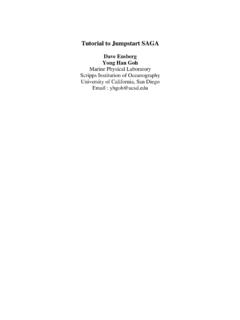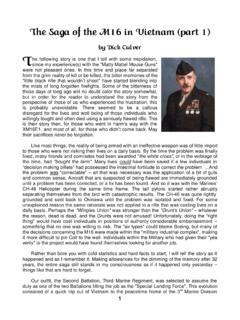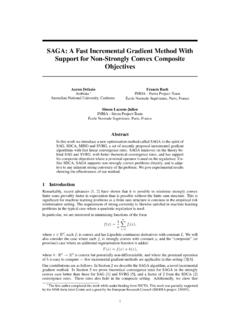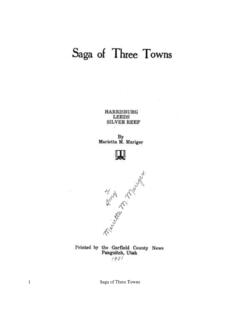Transcription of SAGA OF THE SANPITCH - Sanpete County, Utah
1 1 2 saga OF THE SANPITCH Volume II Winning Entries for the 1970 Sanpete Historical Writing Contest Sponsored by Manti Region of the Church of Jesus Christ of Latter-day Saints Copyright 1970 By Ross P. Findlay For Manti Region of the Church of Jesus Christ of latter-day Saints Printed at Snow College Ephraim, Utah 3 Preface Legend is something like an unhurried stream, flowing easily down through the countryside. Sparkling and rippling along, gurgling and gently splashing as it passes through sunlit places, or changing colors as it goes through the shadows. So it is with traditions and tales as remembered by various members of a community. The legends each remember will depend somewhat on their own characteristics. One story might be quite clear and concise if told by a scholar. The same incident would be very funny if told by a person with a great sense of humor, or it might be sad, if told by someone who was very sensitive.
2 As these stories flow along verbally they are alive and vivid, and change with the teller. To write them down catches them just at one point and how it finally is written depends on the narrator, whether it comes from the sunlight or from the shadow. So it is something of a loss to write the stories and legends that are a rich part of our heritage, but not so great a loss as it would be to lose them altogether. We present then, Volume II of this Collection of Essays, Stories and Poetry, based on incidents in the lives of the early citizens of Sanpete as they have been remembered and written down. It is important to remember that with all of the difficulties and sacrifice encountered by these early settlers, their achievements were very great. And if we find that they had failings, will it not give us more patience to bear our own imperfections?
3 If we should learn that those who built this great cultural empire are remembered by some as less than perfect, will it not give us strength to press forward to accomplish what is required of us, in spite of present difficulties? The cover picture is from a painting by Carl Christian Anton Christensen, (CCA) early Sanpete artist whose paintings have been honored in the May-June issue of Art in America, and In the Whitney Museum of American Art in New York City in July of 1970, to be displayed during the summer months. The cover picture is entitled Norway in the Winter, and is the property of Mrs. Eva Wallace of Ephraim, Utah. We are grateful to Mrs. Wallace for the use of this painting, to Mr. Ross Findlay and Mr. Larry Stahle for producing the cover picture and to the Christensen family for their help and encouragement.
4 Our sincere gratitude to three former Sanpete residents now living in Salt Lake City who served as Judges for the 1970 contest. All are successful writers and have contributed to Utah s Literary legacy. Chris Jensen, native of Ephraim was for a long time author of a column in the Salt Lake Tribune. He is also an artist of note, and has written for magazines of nation-wide circulation. Mrs. Pearle M. Olsen, who spent her early years in Mt. Pleasant, has had poems and articles published in the Relief Society Magazine and other publications, and is co-author of a book on the Madsen family. Mrs. Vesta Pierce Crawford has been writing most of her life. She has been a newspaper correspondent, and in later years has served as assistant editor of the Relief Society magazine. She has received many prizes and awards for her literary achievements.
5 We also express appreciation to Miss Karen Sorensen who typed the manuscripts, Mr. Ross Findlay for printing and assembling, and to members of the Committee, comprised of Miss Jessie Oldroyd of Fountain Green; Mr. Vernile Shelley, Mt. Pleasant; Mrs. Wilma M. Despain of Centerfield; Mrs. Lonnie Wintch and Mrs. Norma Wanlass of Manti and Mrs. Eleanor Madsen of Ephraim. Also our grateful acknowledgement of the help and encouragement of Stake Presidencies in the Manti Region, President Vernon L. Kunz, President Lamar B. Stewart, President Ralph Blackham, President Roger Allred, and to our Regional Representative Clarence Robison of Provo, Utah. 4 Sanpete County Historical Writing Contest 1970 Decisions of: Vesta P. Crawford Pearle M. Olsen Christian Jensen POETRY: THIS LITTLE PIG WENT TO MANTI----------------------------------- --------------------First Place THE HISTORICAL MARKER---------------------------------- -------------------------------Second Place SONNET TO A PIONEER WOMAN----------------------------------- --------------------1st Hon.
6 Mention SANPITCH RIVER----------------------------------- ---------------------------------------- -2nd Hon. Mention ESSAY: ADAM CRAIK SMYTH----------------------------------- -----------------------------------First Place THE DIARY----------------------------------- ---------------------------------------- --------Second Place THE PROPHET MORONI DEDICATION, ETC. ---------------------------------------- 1st Hon. Mention WEEP NOT FOR ME MOTHER ---------------------------------------- -----------------2nd Hon. Mention THE HISTORY OF FUNK S LAKE------------------------------------ ---------------------3rd Hon. Mention STORY: NEH-TIG-A-GAND ---------------------------------------- ---------------------------------First Place THE BIG CHIEF S PROPOSAL ---------------------------------------- --------------------Second Place MY BROTHERS ---------------------------------------- -------------------------------------1st Hon.
7 Mention GRANDMA AND THE INDIANS ---------------------------------------- -----------------2nd Hon. Mention TRIBUTE TO THE UTES ---------------------------------------- ---------------------------3rd Hon. Mention 5 TRIBUTE TO THE UTE Janell Harris, Wales, Utah Short Story, Third Honorable Mention On a warm summer afternoon, I impulsively climbed a dusty red hillside, at the base of the west mountain, that looms solid and still against the sunset. I trudged over rocks and sagebrush until I reached the tip of a small hill that juts independently forward, an erosive ravine on either side. On a large rock, I sat in the shade of a scrub cedar for a short breather. From my lofty perch, I viewed the valley with renewed interest. From snow-rippled Mt. Nebo at the northern tip, to the majestic spires of the Manti Temple to the south.
8 From the plush meadows below, to the stately ridges of the Horseshoe . A hundred or so years ago, on this very spot, an Indian could have occupied this vantage point with an interest of his own. Directly across the valley, Spring City lay peaceful in the sun. A thin gray spiral of smoke from someone s back yard, climbed slowly toward the clouds. It might have been an unsuspecting campfire, or perhaps a log cabin standing unguarded, subject to attack. In the distance, a tiny car sped quietly along the black thread highway, heading south, its windshield reflecting the sun. It might have been a stagecoach or a buckboard, rolling along in a cloud of dust. With one shot from a rifle, or one lusty whoop, a band of renegades could overtake that driver before he reached Pigeon Hollow. A young brave with a keen eye, from this viewpoint, could survey seven distant settlements without moving from his seat.
9 The areas of Mt. Pleasant, Fairview, Moroni, Spring City, Fountain Green, Ephraim, and Manti. And all the valleys and hills in between. My thoughts raced back more than a hundred years, as I tried to picture life as it was in this valley decades ago. In reading about the Indians who occupied this area before white man came, the Ute is described as the lowliest creature of the earth. Living next to starvation in rock overhangs and crevices, in caves, or in crude brush huts. In their poor natural conditions, they dressed in rabbit skins, and dieted on roots and seeds, grasshoppers and jackrabbits. With their nomadic hunting and gathering way of life, their primitive culture was simple and crude. They were as timid as wild creatures, disappearing like shadows at the sight of a stranger. There seems to be a sort of mystery as to the origin of the Ute.
10 Although their ceremonial religion, rock art, and crude utensils were typical of the Aztec Indians of Mexico, their legends of the creation of the world, the beginning of humanity, and the origin of fire suggest that the Ute always existed where he was at the time. No migration legends were passed on. Until they acquired horses, they were known as poor diggers who were sometimes shot at for sport. At the time the white man came, Chief Walker and his brothers Arapeen, SANPITCH , Ammon, and Tobiah, were trying to change the Ute into a mounted warrior tribe. The Sanpete raiders terrorized the settlements by plundering and stealing cattle and horses. Many stories are told of bloody battles, savage attacks, and torture of innocent victims. Their eye for an eye practices were horrifying. I have wondered at the scarred emotions of that hostile breed of humanity.










